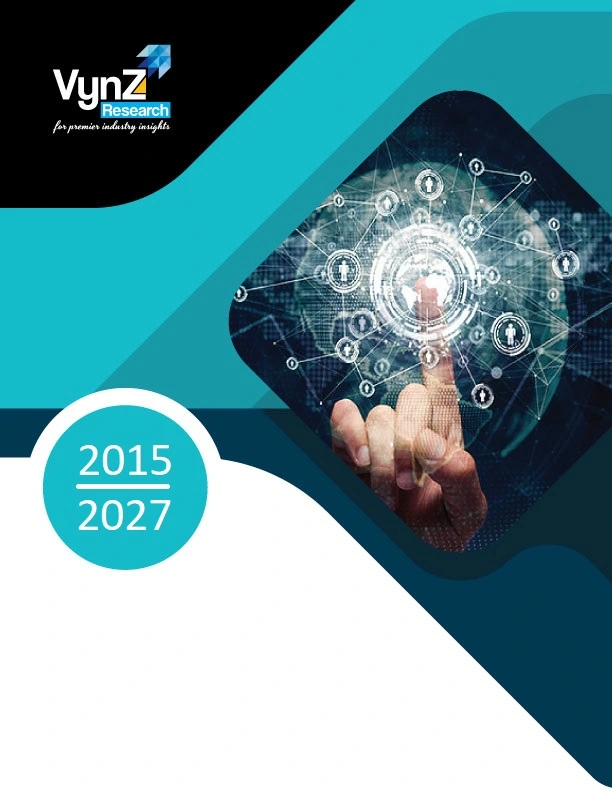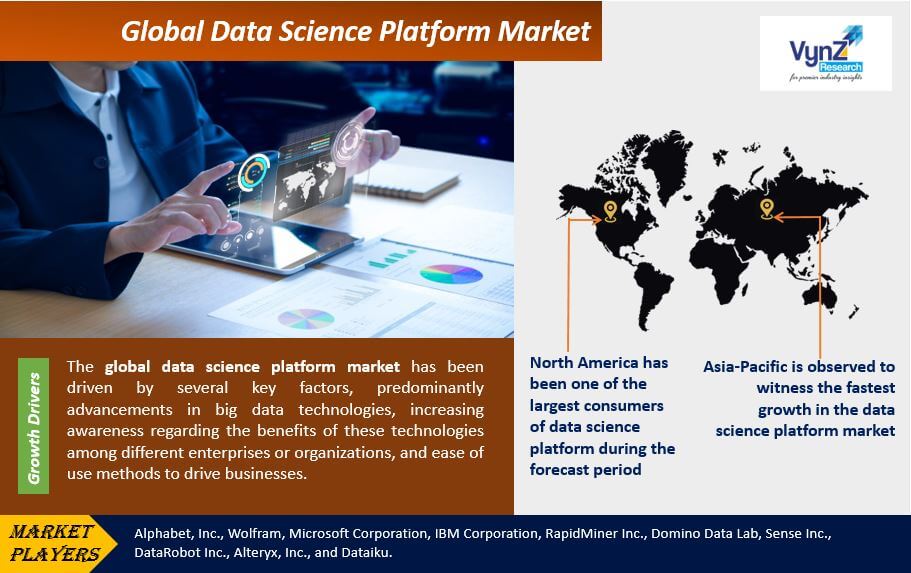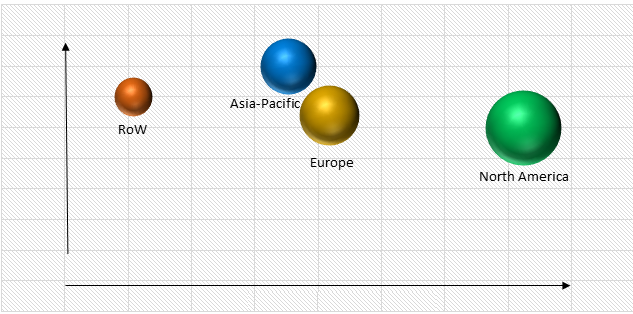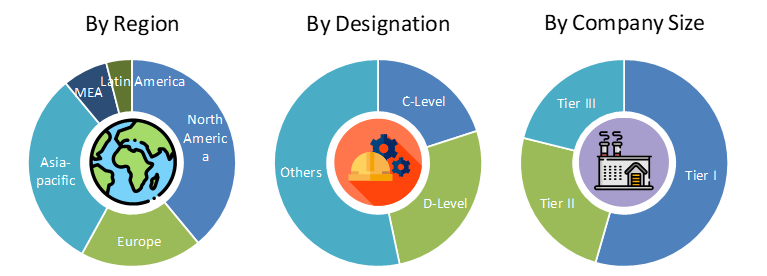| Status : Published | Published On : Mar, 2024 | Report Code : VRICT5029 | Industry : ICT & Media | Available Format :

|
Page : 142 |

Global Data Science Platform Market – Analysis and Forecast (2025-2030)
Industry Insights by Deployment Type (On-Premise, On-Demand), by Business Function (Marketing, Logistics, Customer Support, Human Resource, Sales, Others), by Industry Vertical (IT & Telecom, Healthcare & Life Sciences, Retail & Consumer Goods, Transportation & Logistics, Media & Entertainment, Banking, Financial Services, and Insurance (BFSI), Others) and by Geography (North America, Europe, Asia-Pacific, Middle East and Rest of the World)
Industry Overview
The Global Data Science Platform Market is projected to reach USD 292.9 billion by 2030 from USD 103.5 billion in 2023 registering a CAGR of 41.1% during the forecast period (2025-2030).
Data science technology has widespread usage across several industries and it is this penetration that has fueled the growth of this market worldwide. The use of these platforms is widespread among data scientists, computer scientists, physicists, mathematicians, and also public health professionals.The rising adoption of cloud-based platforms in new markets such as Brazil and the Gulf Cooperation Council (GCC) countries also has resulted in the growth of this market.

Data Science Platform Market Segmentation
Insight by Deployment Type
Based on deployment type, the global data science platform market is divided into two specific heads namely, on-premise and on-demand. Out of these two, the on-premise segment contributes to the market more than the latter.
Insight by Business Function
Based on business function or application, the global data science platform market is typically divided into business operation, marketing, customer support, logistics, finance, accounting, and more.
Out of all these segments, the marketing segment will grow at a fast rate during the forecast period. This is mainly due to the rise in use of the social media. This, in turn, allows the platform to analyze the popularity of a product in real-time. Based on the findings, it, in turn, helps in creating better strategies for marketing a product.
However, in terms of market share during the same period, that of the customer support section is expected to gain maximum. This is mainly due to the ever-changing buying preferences of the consumers, which leads to higher adoption of this platform across a wide range of industries.
Insight by Industry Verticals
According to the business functions, the market is divided into healthcare, life sciences, retail, consumer goods, logistics, transportation, CFSI, media and entertainment, IT and telecom, and more.
Out of all these, the BFSI segment holds the largest share and is expected to hold its position during the forecast period. This is due to the utilization of this platform by this sector for different major applications and operations, such as collection and marketing analytics, fraud analytics, risk assessment and mitigation, regulatory compliance, operation analytics, and credit policy adherence. All these lead to higher adoption.
Global Data Science Platform Market Report Coverage
|
Report Metric |
Details |
|
Historical Period |
2018 - 2023 |
|
Base Year Considered |
2024 |
|
Forecast Period |
2025 - 2030 |
|
Market Size in 2024 |
U.S.D. 103.5 Billion |
|
Revenue Forecast in 2030 |
U.S.D. 292.9 Billion |
|
Growth Rate |
41.1% |
|
Segments Covered in the Report |
By Deployment Type, By Business Function Type,and By Industry Vertical |
|
Report Scope |
Market Trends, Drivers, and Restraints; Revenue Estimation and Forecast; Segmentation Analysis; Impact of COVID-19; Companies’ Strategic Developments; Market Share Analysis of Key Players; Company Profiling |
|
Regions Covered in the Report |
North America, Europe, Asia-Pacific, Middle East, and Rest of the World |
Industry Dynamics
Data Science Platform Market Growth Drivers
The convenience and ease of use of this technology contribute to its growth factor. The platform can simplify a wide range of processes which specifically helps the BFSI sector, which is known for its complicated processes. Also, this sector is very vulnerable to data fraud and theft due to large data inputs from various sources. This specific technology offers a diverse range of benefits. This is mainly due to the rapid and significant advancements made in the technologies used. It can analyze and manage large datasets and provide valuable insights to organizations to make accurate and productive decisions to optimize opportunities and operations. Also, there is an increased awareness among consumers, organizations, and enterprises. The platform helps businesses to know potential trends and patterns through machine learning and advanced analytics, all related to the available data. Add to that, Artificial Intelligence and Machine Learning technologies have developed significantly over the years and are used in almost all fields today. They help data analysts and scientists create new algorithms and more advanced task models such as image recognition, natural language processing, and anomaly identification, all propelling the market growth.
Big data technologies also help the data science platform market to grow. Technologies like Spark and Apache Hadoop help in analyzing and processing large amounts of data, both structured and unstructured. The use of the cloud has also helped data science platforms a great deal. It offers scalability, easy accessibility, and flexibility and eliminates the need for on-site infrastructure, thereby reducing costs.
Data Science Platform Market Restraints
The technology, as such, is not very reliable which pulls it back a bit. Also, most people are not quite familiar with it.The rules and regulations imposed by the government on this technology are also quite harsh, thereby hindering rapid adoption.
Data privacy and security are not 100% foolproof as of now. Some significant issues need to be taken into account and resolved. There is a significant amount of investment involved in these platforms. Moreover, users need to upgrade their platform from time to time to ensure reliability and compatibility with advanced technologies and data tools. These are however not significant hindrances to the market growth and several initiatives are being taken to mitigate them and ensure the growth of the data science platform market during the forecast period.
Data Science Platform Market Geographic Overview
North America has the largest consumers and therefore the largest contributor to this market. It is supposed to be so in the forecast period. It is due to the favorable initiatives of the government that support the BFSI sector which has a larger presence. Moreover, there is a high awareness of the benefits of this technology among people and the advanced IT infrastructure across various industry verticals.
However, the market in the Asia-Pacific region is also expected to grow at a rapid pace during the forecast period. This is mainly due to the immense opportunities available for the BFSI sector in these countries in addition to a huge customer base. The telecom and IT infrastructure is also developing in these regions, just as transportation, healthcare, life sciences, and logistics are. These sectors use a large volume of data that requires an efficient platform for accurate analysis.
Global Data Science Platform Market, By Region

Asia-Pacific is observed to witness the fastest growth in the data science platform market during the forecast period. As the region offers immense opportunities for banking and finance sectors and large customer base. Also, the developing infrastructures for IT and telecom, healthcare and life sciences, and transportation and logistics require the need for efficient analysis of large volume data, thus fueling the growth of the industry in the region.
Key Players Covered in the Report
Some of the key players operating in the global data science platform market are Alphabet, Inc., Wolfram, Microsoft Corporation, IBM Corporation, RapidMiner Inc., Domino Data Lab, Sense Inc., DataRobot Inc., Alteryx, Inc., and Dataiku.
Recent developments by Key Players
Recently, Google and Deloitte has collaborated to connect data science and marketing with AI. With this partnership, customers shall build and train machine learning (ML) models. Businesses can develop chatbots, search engines and other tools, with the help of Google Cloud’s Generative AI App Builder and Studio. The suite of tools uses the Google Cloud Cortex Framework to help enterprises enhance data and generate insights about how they operate, plan and forecast. Furthermore, consumers are allowed to view analytics in real time and applies BigQuery, Data Flow and Dataproc to help them use structured and unstructured data.
Microsoft has launched Fabric for the new platform. To enable data management and analysis, including developing AI models, the suite unites Power BI, Azure Synapse Analytics and Data Factory in an integrated environment. The tech giants and independent vendors have responded by moving quickly over the past year to develop and bring generative AI-based systems to market. In addition to making Fabric available to all customers, Microsoft unveiled the preview of Copilot in Fabric. The natural language processing (NLP) tool enables users to query their data and generate code using conversational language.
The global Data Science Platform Market report offers a comprehensive market segmentation analysis along with an estimation for the forecast period 2025–2030.
Segments Covered in the Report
- By Deployment Type
- On-Premise
- On-Demand
- By Business Function Type
- Marketing
- Logistics
- Customer Support
- Human Resource
- Sales
- Others
- By Industry Vertical
- IT and Telecom
- Healthcare and Life Sciences
- Retail and Consumer Goods
- Transportation and Logistics
- Media and Entertainment
- BFSI
- Others
Region Covered in the Report
- North America
- U.S.
- Canada
- Mexico
- Europe
- Germany
- U.K.
- France
- Italy
- Spain
- Russia
- Rest of Europe
- Asia-Pacific (APAC)
- China
- Japan
- India
- South Korea
- Rest of Asia-Pacific
- Rest of the World (RoW)
- Brazil
- Saudi Arabia
- South Africa
- U.A.E.
- Other Countries
PRIMARY RESEARCH INTERVIEWS - BREAKDOWN

Frequently Asked Questions
Purchase Options
Latest Report
Research Methodology
- Desk Research / Pilot Interviews
- Build Market Size Model
- Research and Analysis
- Final Deliverabvle
Connect With Our Sales Team
- Toll-Free: 1 888 253 3960
- Phone: +91 9960 288 381
- Email: enquiry@vynzresearch.com
Data Science Platform Market
